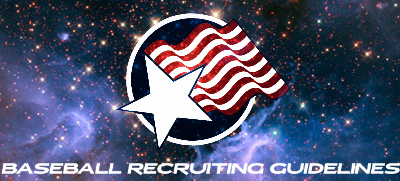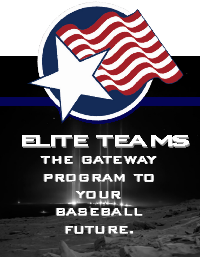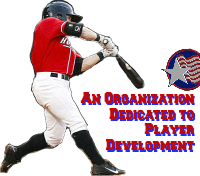
BASEBALL RECRUITING GUIDELINES
You may assume that the statistical data provided below is meant to serve only as a guideline. Meeting or exceeding the guidelines is not a guarantee that you will produce the desired results you seek. Not meeting the guidelines is also not a guarantee that you will not reach the level you seek. The guidelines focus on the collegiate level of play. Professional prospects are held to an even higher standard and usually project well in many areas. Use this guide as a starting point and challenge yourself to exceed these guidelines through deliberate, perfect practice.
Division I Baseball
The typical Division I player is ‘polished’ and already has all the tools necessary to be successful as a freshman. As opposed to the Division II baseball player, the typical DI player needs far less development. Position players possess at least 4 of 5 measurable tools. Pitchers display a command of at least 3 pitches with high velocities. They have the ability to throw many innings, and most often are only used as pitchers. Most DI players have been awarded accolades such as All-Area, All-County, or All-State early in their high school career. Most DI programs identify prospects their freshman and sophomore years, many of these recruits verbally commit junior year, and these programs mainly wrap up recruiting by the early signing period senior year.
Pitchers: Must have sound mechanics, good fielding skills and show poise under pressure.
-Over 1 strikeout (K) per Inning Pitched
-Velocity: As low as 86 MPH consistently to 95+ (Verified by a reliable source)
(RHP 86 - 95 mph, LHP 84 - 92 mph.)
-2 Additional pitches thrown to spots consistently with good movement, late break and accuracy.
Catchers: Must be able to handle pitchers, frame, drop and block and throw runners out.
-Height: 5'10” or taller
-Weight: 180 lbs.
-Pop Time: 1.95 and below consistently (Verified by a reliable source)
Middle Infielders: Should have good range, quick exchange, a strong arm and be able to turn double plays.
-Height: 5'10”
-Weight: 180 lbs.
-60 Yard Dash: 6.8 or below (Verified by a reliable source)
-Home to 1st:
Right-Handed Hitter: 4.1 or below, Left-Handed Hitter: 4.0
-Velocity from the INF: 85+ MPH (Verified by a reliable source)
Corner Infielders: Should handle hard hit balls, have a quick exchange and a strong arm across the field.
-Height: 6’0”
-Weight: 200 lbs.
-60 Yard Dash: 7.25 or below
-Velocity from the INF: 85+ MPH (Verified by a reliable source)
-Should be able to hit for power as well as average.
Outfielders: Should cover ground, field anything hit to their position and make strong accurate throws.
-Height: 6'1"
-Weight: 180 lbs.
-60 Yard Dash: 6.8 (Verified by a reliable source) Home to 1B: RH Hitter: 4.1 or faster, LH Hitter: 4.0.
-Velocity from the OF: 85+ MPH (Verified by a reliable source)
Division II Baseball
DII recruits may not throw as hard, play for the top high schools programs, or possess at least 4 of the 5 measurable tools. Student-athletes should be meeting the guidelines below by the summer before their senior year as many division two programs recruit student-athletes who may not have been picked up by division one programs after the early signing period. Many highly ranked DII programs are as competitive as some DI programs and players are drafted by MLB every year from many DII programs.
Pitchers: Must have sound mechanics, good fielding skills and show poise under pressure.
-Averaging about 1K per inning pitched
-Velocity: As low as 81 MPH consistently
(RHP 85+ mph, LHP 81 mph.)
-2 Additional pitch thrown to spots consistently with good accuracy and at will.
Catchers: Must be able to handle pitchers, frame, drop and block and throw runners out.
-Height: 5'10’’
-Weight: 175 lbs.
-Pop Time: 2.0 or faster
-60 Yard Dash: 7.25 or faster
Middle Infielders: Should have good range, quick exchange, a strong arm and be able to turn double plays.
-Height: 5’10’’
-Weight: 175 lbs.
-60 Yard Dash: 6.9 or below
-Home to 1st: Right-Handed Hitter: 4.3 or below, Left-Handed Hitter: 4.2
-Velocity from the INF: Low 80’s mph
Corner Infielders: Should handle hard hit balls, have a quick exchange and have a strong arm across the field.
-Height: 5’11”
-Weight: 180 lbs.
-60 Yard Dash: 7.25 or below
-Should be able to hit for power as well as average.
Outfielders: Should cover ground, field anything hit to their position and make strong accurate throws.
-Height: 5'10’’
-Weight: 175 lbs.
-60 Yard Dash: 6.8 or below
-Home to 1st: Right-Handed Hitter: 4.2 or faster, Left-Handed Hitter: 4.1 or faster
-Velocity from the OF: 82-86 MPH
Division III Baseball
Some DIII programs are stronger than others, but there seems to be more continuity with the physical characteristics of DIII players than there are for DII or NAIA. Certain DIII programs, such as Wisconsin Whitewater or George Fox recruit student-athletes who miss out on opportunities with the least selective DI programs. Student-athletes should be meeting the criteria below by the beginning of senior year when most division three programs start heavily recruiting players. Statistic to Keep in Mind: There are no Division III colleges that offer baseball in Florida and only eight in the Southeast states of Alabama, Georgia, South Carolina, and Florida. This is one of the most saturated areas of baseball talent and this means there is even more competition for programs at other division levels.
Pitchers: Must have sound mechanics, good fielding skills and show poise under pressure.
-Approximately 1 K per Inning Pitched
-Velocity: As low at 80 MPH consistently
(RHP 82 mph, LHP 80 mph.)
-1 Additional pitch thrown to spots consistently with good movement, late break and accuracy.
Catchers: Must be able to handle pitchers, frame, drop and block and throw runners out.
-Height: 5’10”
-Weight: 170 lbs.
-Pop Time: 2.1 or below
-60 Yard Dash: 7.40 or below
Middle Infielders: Should have good range, quick exchange, a strong arm and be able to turn double plays.
-Height: 5’10”
-Weight: 165 lbs.
-60 Yard Dash: 7.25 or faster -Home to 1st: Right-Handed Hitter: 4.4 or faster, Left-Handed Hitter: 4.3 or
faster
-Velocity from the INF: Upper 70’s mph
Corner Infielders: Should handle hard hit balls, have a quick exchange and have a strong arm across the field.
-Height: 5’10”
-Weight: 170 lbs.
-60 Yard Dash: 7.35 or faster
-Should be able to hit for power as well as average.
Outfielders: Should cover ground, field anything hit to their position and make strong accurate throws.
-Height: 5’10”
-Weight: 170 lbs.
-60 Yard Dash: 7.30 or faster
-Home to 1st: Right-Handed Hitter: 4.3 or below, Left-Handed Hitter: 4.2
-Velocity from the OF: 78+ MPH
NAIA Baseball
The discrepancies in characteristics are very severe when it comes to NAIA baseball. Most compete at a division two level. The most selective NAIA programs are best compared to a low DI level program. The least selective are competing at a low DIII level. Keep in Mind: There are only five NAIA programs located in the Northeast and New England area.
Junior College Baseball
Similar to the NAIA level there are many discrepancies in characteristics between the top level programs and the least selective programs. The most selective junior colleges in the country recruit mid to upper level DI student-athletes. Lower level JUCO programs recruit low level DIII players. Also, unlike the NAIA, junior colleges do have 3 divisions for the purpose of separating stronger JUCO programs from the weaker ones. While there may be somewhat of a drop off in talent between Division III junior college and Division I and Division II junior colleges, there is little difference between DI and DII junior colleges. Many of the junior college players lack the ‘polish’ to be considered DI players coming out of HS, but they already possess the necessary physical tools to be successful at high levels. Many times, these recruits need to harness and polish those tools. Additionally, some Junior College players may have been drafted as seniors in high school but decided to go to college and would like to try to get drafted again at a higher level. A year of JUCO competition might season a player to achieve this goal. At times, the GPA’s of some junior college athletes are lower than those attending four year schools, suggesting that these athletes need two years to mature academically. Statistics to Keep in Mind: There are 88 junior colleges located in California alone. About 175 players are selected from the NJCAA in the MLB Draft each year.
Baseball by the Numbers :
Schools Offering Baseball:
NCAA Division I - 298, NCAA Division II - 259, NCAA Division III - 374, NAIA - 212, Junior College - 511, Total - 1,653.
These numbers are approximate and subject to change each year.
Athletic Scholarship Opportunities:
Division I (per school) - 11.7, Division II (per school) - 9, NAIA (per school) - 12, NJCAA (*varies per school) - 24
Student-Athlete Participation (Approx.):
NCAA Division I - 10,400, NCAA Division II - 9,000, NCAA Division III - 11,200, NAIA - 6,300, Junior College - 15,300
HS Student-Athletes*
Approximately - 473,503
Note: Division III schools offer merit, academic, and need-based scholarships.
*Per the National Federation of State High School Associations Participation Data (2009 - 2010)
As you can see, nothing is more important than excellent player development. To learn more about player development



.jpg)
.jpg)


